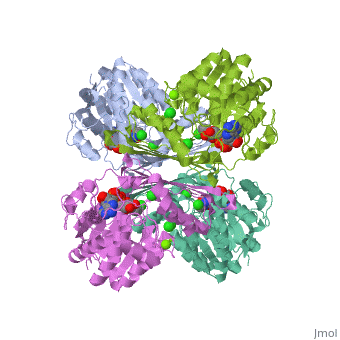The Structure and Mechanism of Hexokinase
From Proteopedia
| Line 1: | Line 1: | ||
==The Structure and Mechanism of Glucokinase (Hexokinase D)== | ==The Structure and Mechanism of Glucokinase (Hexokinase D)== | ||
| - | Glucokinase (hexokinase D) is a monomeric cytoplasmic enzyme found in the liver and pancreas but can also be found in the gut and brain. It serves to regulate glucose levels in these organs. Glucokinase uses phosphorylation to increase the metabolism of glucose. | + | Glucokinase (hexokinase D) is a monomeric cytoplasmic enzyme found in the liver and pancreas but can also be found in the gut and brain. It serves to regulate glucose levels in these organs. Glucokinase uses phosphorylation to increase the metabolism of glucose. Glucokinase is a hexokinase isoenzyme All hexokinases are capable of prompting the first step of glycogen synthesis and glycolysis, the phosphorylation of glucose to glucose-6-phosphate. Glucokinase is unique from other hexokinase in kinetic properties and is coded by a different gene. The reduced affinity for glucose allows the activity of glucokinase to differ under physiological conditions according to the amount of glucose present. |
| - | + | ||
| - | + | ||
| - | + | ||
| - | + | ||
| - | + | ||
| + | '''Role in Organ Systems:''' In the liver glucokinase increases the synthesis of glycogen and is the first step in glycolysis, the main producer of ATP in the body. Glucokinase is responsible for phospohorylating the majority of glucose in the liver and pancreas. Glucokinase only binds to and phosphorylates glucose when levels are higher than normal blood glucose level, allowing it to maintain constant glucose levels<ref>PMID:15016359 </ref>. By phosphorylating glucose, glucokinase creates glucose 6-phosphate. Glucose 6-phosphate can then be used by the liver through the glycolytic pathway. Along with this process in the liver, glucokinase also facilitates glycogen synthesis. Through this the majority of the body's glucose is stored. Glucose 6-phosphate is also one of the starting materials of the TCA cycle which is responsible for the majority of ATP production in the body. | ||
In the pancreas, a rise in glucose levels increases the activity of glucokinase causing an increase in glucose 6-phosphate. This causes the triggering of the beta cells to secret insulin<ref>PMID:11237213</ref>. Glucokinase is the first step in this reaction. Insulin then allows other cells in the body to take up glucose, actively lowering the glucose level. Glucokinase can also phosporylate other proteins, specifically hexoses. Glucokinase is inhibited by glucokinase regulatory protein, which becomes active in low glucose environments. | In the pancreas, a rise in glucose levels increases the activity of glucokinase causing an increase in glucose 6-phosphate. This causes the triggering of the beta cells to secret insulin<ref>PMID:11237213</ref>. Glucokinase is the first step in this reaction. Insulin then allows other cells in the body to take up glucose, actively lowering the glucose level. Glucokinase can also phosporylate other proteins, specifically hexoses. Glucokinase is inhibited by glucokinase regulatory protein, which becomes active in low glucose environments. | ||
Revision as of 06:06, 1 March 2010
The Structure and Mechanism of Glucokinase (Hexokinase D)
Glucokinase (hexokinase D) is a monomeric cytoplasmic enzyme found in the liver and pancreas but can also be found in the gut and brain. It serves to regulate glucose levels in these organs. Glucokinase uses phosphorylation to increase the metabolism of glucose. Glucokinase is a hexokinase isoenzyme All hexokinases are capable of prompting the first step of glycogen synthesis and glycolysis, the phosphorylation of glucose to glucose-6-phosphate. Glucokinase is unique from other hexokinase in kinetic properties and is coded by a different gene. The reduced affinity for glucose allows the activity of glucokinase to differ under physiological conditions according to the amount of glucose present.
Role in Organ Systems: In the liver glucokinase increases the synthesis of glycogen and is the first step in glycolysis, the main producer of ATP in the body. Glucokinase is responsible for phospohorylating the majority of glucose in the liver and pancreas. Glucokinase only binds to and phosphorylates glucose when levels are higher than normal blood glucose level, allowing it to maintain constant glucose levels[1]. By phosphorylating glucose, glucokinase creates glucose 6-phosphate. Glucose 6-phosphate can then be used by the liver through the glycolytic pathway. Along with this process in the liver, glucokinase also facilitates glycogen synthesis. Through this the majority of the body's glucose is stored. Glucose 6-phosphate is also one of the starting materials of the TCA cycle which is responsible for the majority of ATP production in the body. In the pancreas, a rise in glucose levels increases the activity of glucokinase causing an increase in glucose 6-phosphate. This causes the triggering of the beta cells to secret insulin[2]. Glucokinase is the first step in this reaction. Insulin then allows other cells in the body to take up glucose, actively lowering the glucose level. Glucokinase can also phosporylate other proteins, specifically hexoses. Glucokinase is inhibited by glucokinase regulatory protein, which becomes active in low glucose environments.
Structure:
| |||||||||
| 3cin, resolution 1.70Å () | |||||||||
|---|---|---|---|---|---|---|---|---|---|
| Ligands: | , , | ||||||||
| Gene: | TM1419, TM_1419 (Thermotoga maritima MSB8) | ||||||||
| Activity: | Inositol-3-phosphate synthase, with EC number 5.5.1.4 | ||||||||
| |||||||||
| |||||||||
| Resources: | FirstGlance, OCA, RCSB, PDBsum, TOPSAN | ||||||||
| Coordinates: | save as pdb, mmCIF, xml | ||||||||
Proteopedia Page Contributors and Editors (what is this?)
Kyle Schroering, Ann Taylor, Michal Harel, Drew McCaffrey, Alexander Berchansky, Karsten Theis, Joel L. Sussman, Cody Leatherman, David Canner


